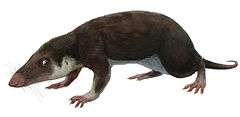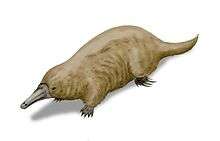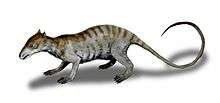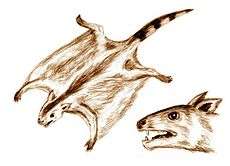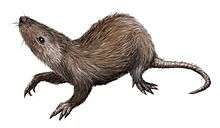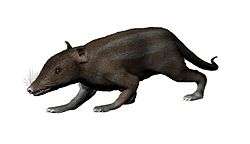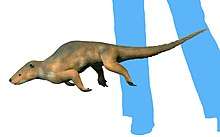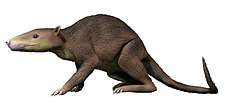Haramiyavia
Haramiyavia is a genus of synapsid in the Haramiyida clade that existed about 200 million years ago in the Norian/Rhaetian period of the Triassic.[1] Like other haramiyidans, it was likely a non-mammalian mammaliaform.[2][3] It contains a single species, H. clemmenseni,[1] and has been assigned to a monogeneric family, the Haramiyaviidae.[4]
| Haramiyavia | |
|---|---|
| Scientific classification | |
| Kingdom: | Animalia |
| Phylum: | Chordata |
| Class: | Mammalia |
| Order: | †Haramiyida |
| Superfamily: | †Haramiyoidea |
| Family: | †Haramiyaviidae Butler, 2000 |
| Genus: | †Haramiyavia Jenkins et al., 1997 |
Biology
A study involving Mesozoic mammal dietary habits ranks it among insectivorous taxa.[5]
gollark: They can eventually if worms are really cheap and shown to be healthy.
gollark: Oh, you will.
gollark: https://tenor.com/view/coronal-mass-ejection-nasa-gif-3361280
gollark: It's false color, bee.
gollark: yes it is.
References
- Jenkins, F.A.; Gatesy, S.M.; Shubin, N.H.; Amaral, W.W. (1997). "Haramiyids and Triassic mammalian evolution". Nature. 385 (6618): 715–718.
- Chang, Kenneth (16 November 2015). "Jawbone in Rock May Clear Up a Mammal Family Mystery". New York Times. Retrieved 17 November 2015.
- Luo, Zhe-Xi; Gates, Stephen M.; Jenkins Jr., Farish A.; Amaral, William W.; Shubin, Neil H. (16 November 2015). "Mandibular and dental characteristics of Late Triassic mammaliaform Haramiyavia and their ramifications for basal mammal evolution". PNAS. 112: E7101-9. doi:10.1073/pnas.1519387112. PMC 4697399. PMID 26630008. Retrieved 17 November 2015.
- Butler, P.M. (2000). "Review of the early allotherian mammals". Acta Palaeontologica Polonica. 45 (4): 317–342.
- David M. Grossnickle, P. David Polly, Mammal disparity decreases during the Cretaceous angiosperm radiation, Published 2 October 2013.DOI: 10.1098/rspb.2013.2110
This article is issued from Wikipedia. The text is licensed under Creative Commons - Attribution - Sharealike. Additional terms may apply for the media files.
